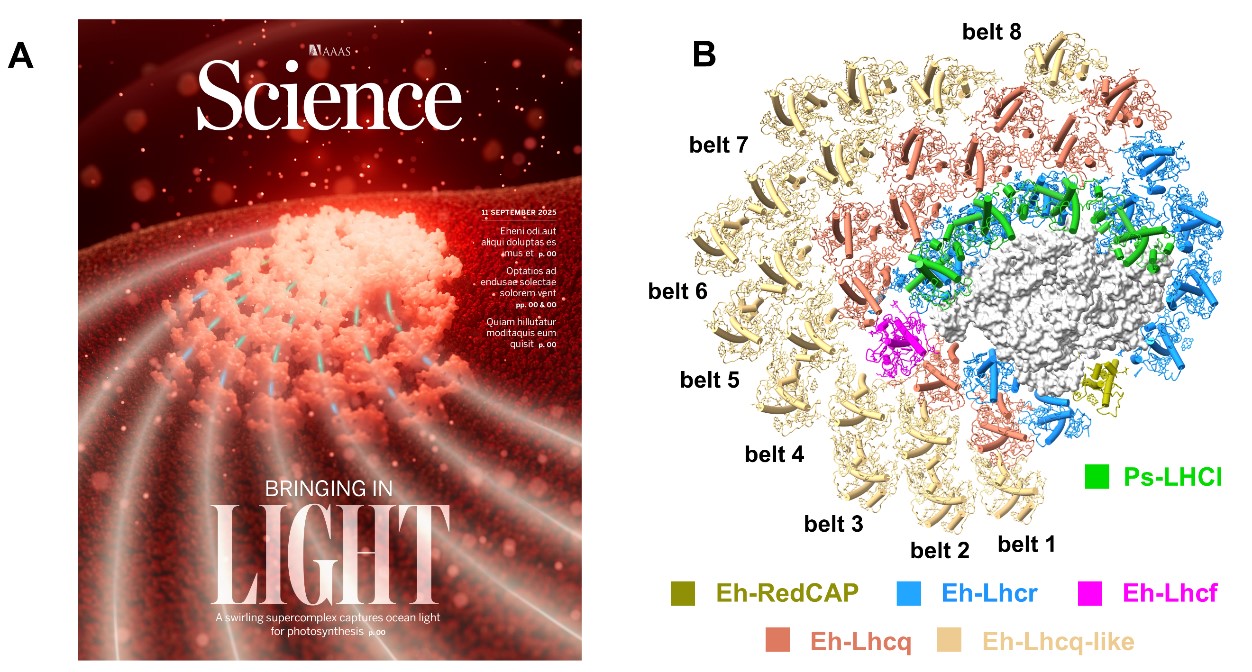On September 11, Science featured the work of Chinese researchers on its cover. A team co-led by Prof. WANG Wenda and Prof. TIAN Lijin from the Institute of Botany, Chinese Academy of Sciences, together with collaborators, reports the first three-dimensional structure of the photosystem I–fucoxanthin–chlorophyll a/c-binding protein supercomplex (PSI-FCPI) from a coccolithophore. The study reveals how this giant photosynthetic machine can expand its light-harvesting cross-section by 3–4 fold while still maintaining over 95% energy conversion efficiency.
The study reported the structural and pigment features of PSI-FCPI in Emiliania huxleyi, showing that it is composed of 51 protein subunits and 819 pigments with a total molecular mass of 1.66 MDa. It is identified as the largest eukaryotic PSI complex, and its light-harvesting cross-section is enlarged to 4-5 times that of the pea PSI-LHC supercomplex. They demonstrated that this PSI-FCPI has ultrafast energy transfer within 96-120 picoseconds, thus endowing a high quantum efficiency above 95% during converting light energy to electrons.
The high efficiency of PSI-FCPI relies on its unique antenna protein and pigment arrangement. Thirty-eight peripheral Eh-FCPIs antennae encircle the PSI core in eight radial belts, pieced together from canonical Lhcq and the newly identified Lhcq-like subunits. The resulting “giant light-harvesting antenna system” greatly enlarges the absorption ability.
These FCPI antennas are enriched in chlorophyll c and fucoxanthin-type carotenoids, enabling effective absorption of blue-green (460-490 nm) and green (490-540 nm) light under ocean water. Moreover, strong excitonic coupling between chlorophyll c and chlorophyll a eliminates energy traps and builds a smooth and efficient energy transfer network, ensuring rapid and stable delivery of excitation energy to the PSI reaction center.
Coccolithophores play an important role in the global carbon cycle. They flourished during the Cretaceous period, leaving massive “chalk” deposits in sediments due to their calcium carbonate plates. This huge PSI-FCPI represents the ultimate expansion of light-harvesting structures under the evolutionary context of red-lineage secondary endosymbiosis. The finding not only provides insights into the adaptive evolution of this ancient lineage but also deepens our understanding of photosynthetic strategies in marine organisms.

A high efficient PSI-FCPI supercomplex of coccolithophore featured by Science as a cover story (A) and its three-dimensional structure (B) (Image by IBCAS)
On September 11, Science featured the work of Chinese researchers on its cover. A team co-led by Prof. WANG Wenda and Prof. TIAN Lijin from the Institute of Botany, Chinese Academy of Sciences, together with collaborators, reports the first three-dimensional structure of the photosystem I–fucoxanthin–chlorophyll a/c-binding protein supercomplex (PSI-FCPI) from a coccolithophore. The study reveals how this giant photosynthetic machine can expand its light-harvesting cross-section by 3–4 fold while still maintaining over 95% energy conversion efficiency.
The study reported the structural and pigment features of PSI-FCPI in Emiliania huxleyi, showing that it is composed of 51 protein subunits and 819 pigments with a total molecular mass of 1.66 MDa. It is identified as the largest eukaryotic PSI complex, and its light-harvesting cross-section is enlarged to 4-5 times that of the pea PSI-LHC supercomplex. They demonstrated that this PSI-FCPI has ultrafast energy transfer within 96-120 picoseconds, thus endowing a high quantum efficiency above 95% during converting light energy to electrons.
The high efficiency of PSI-FCPI relies on its unique antenna protein and pigment arrangement. Thirty-eight peripheral Eh-FCPIs antennae encircle the PSI core in eight radial belts, pieced together from canonical Lhcq and the newly identified Lhcq-like subunits. The resulting “giant light-harvesting antenna system” greatly enlarges the absorption ability.
These FCPI antennas are enriched in chlorophyll c and fucoxanthin-type carotenoids, enabling effective absorption of blue-green (460-490 nm) and green (490-540 nm) light under ocean water. Moreover, strong excitonic coupling between chlorophyll c and chlorophyll a eliminates energy traps and builds a smooth and efficient energy transfer network, ensuring rapid and stable delivery of excitation energy to the PSI reaction center.
Coccolithophores play an important role in the global carbon cycle. They flourished during the Cretaceous period, leaving massive “chalk” deposits in sediments due to their calcium carbonate plates. This huge PSI-FCPI represents the ultimate expansion of light-harvesting structures under the evolutionary context of red-lineage secondary endosymbiosis. The finding not only provides insights into the adaptive evolution of this ancient lineage but also deepens our understanding of photosynthetic strategies in marine organisms.

A high efficient PSI-FCPI supercomplex of coccolithophore featured by Science as a cover story (A) and its three-dimensional structure (B) (Image by IBCAS)
